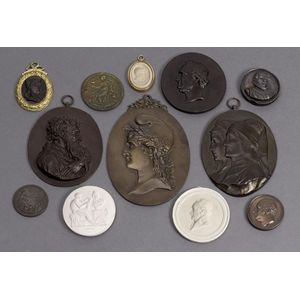Antique Medals and Plaques Collection
You must be a subscriber, and be logged in to view price and dealer details.
Subscribe Now to view actual auction price for this item
When you subscribe, you have the option of setting the currency in which to display prices to $Au, $US, $NZ or Stg.
- Ormolu - Ormolu was popular with French craftsmen in the 18th and 19th century for ornamental fittings for furniture, clocks and other decorative items. True ormolu is gilt bronze, that is bronze that has been coated with gold using a mercury amalgam. Due to the health risks associated with using mercury, this method of creating ormolu was discontinued in France in the 1830s. A substitute was developed consisting of about 75% copper and 25% zinc, however it was inferior to the bronze version. It was often lacquered to prevent it tarnishing.
- Bronze - An alloy of copper and tin, traditionally in the proportions of about 9 parts of copper to 1 part of tin.
The discovery of bronze in Western Asia in the 4th century enabled people to create metal objects which were superior to those previoulsy possible because of its strength and hardness, and it has been used throughout the world for weapons, coins, tools, statuary and other decorative items.
It is very fluid in a molten state, and its hardness, strength when set, and non-corrosive properties makes it most suitable for casting sculpture. - Dexter - The words dexter and sinister are commonly used in heraldry, but have a more general application in the world of antiques and collectables (mainly sculpture and numismatics) to describe the position of the head of the subject. Dexter, which is Latin for right means the subject is looking to their right, while sinister, which is Latin for left, means the subject is looking to their left.
This item has been included into following indexes:
Visually similar items

2 Chinese Kirin Province 3 Mace 6 Candareens coins, silver 3.4 cm diameter, together with a small collection of Hong Kong and oriental coins

Aeronautical medals (9) including '9th Aerial Olympics'; plus French Foreign Affairs medal & first National city Bank (New York ). (11 items)

Ten Del Ware enamel and copper dishes, decorated in enamel on copper with Maori cave art designs. Diameter 10 cm

Pair circa 18th under-glass buttons painted with caricature monkey figures (one with back loop shank missing)
